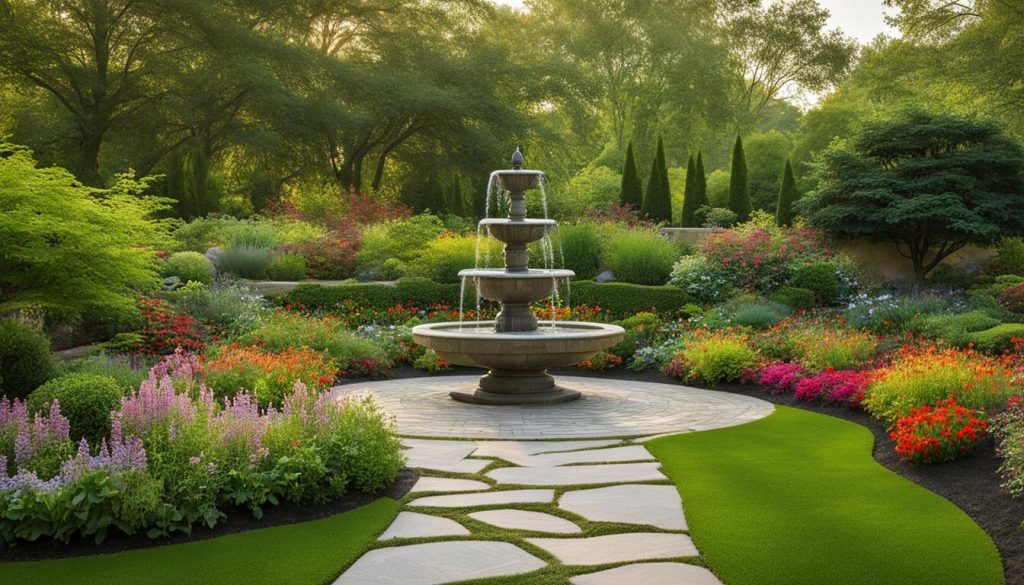At Landscaping Etobicoke , we believe that a beautiful and functional garden can transform your outdoor space into a peaceful haven. Our team of professionals has put together a comprehensive guide to help you create a stunning garden that reflects your personality and style.
With our expert tips and design inspiration, you can transform your garden into an enchanting oasis that you can enjoy year-round. Whether you are starting from scratch or looking for some creative ideas to refresh your existing garden, we’ve got you covered. Keep reading to discover how to make the most of your outdoor space with our garden landscaping ideas.
Are you ready to create a stunning garden that will leave your neighbors green with envy? Let’s get started!
Assessing Your Garden Space
In order to create a stunning garden, it’s essential to start with evaluating your garden space. No matter the size or shape of your garden, understanding its characteristics is crucial for designing a tailored landscaping plan that maximizes its potential. By assessing your garden, you can create a well-planned layout that achieves a harmonious and inviting space.
Here are a few things to consider when assessing your garden:
- Garden space: Start with measuring your garden’s dimensions and record them. This will help determine the amount of space you have to work with and inform your decision on what features you can incorporate.
- Topography: Take notice of any slopes or inclines within your garden. These areas can affect plant growth and may require additional preparation or retaining walls.
- Sunlight: Determine which parts of your garden receive the most sunlight throughout the day. This will help you decide where to place certain plants and features that require specific light conditions.
- Existing features: Take note of any existing plants, trees, or structures within your garden. These elements can serve as focal points or become integrated into your landscaping plan.
Assessing your garden space is an important first step in the garden landscaping process. By understanding the unique characteristics of your garden, you can create a tailored plan that will bring out the best in your outdoor space.
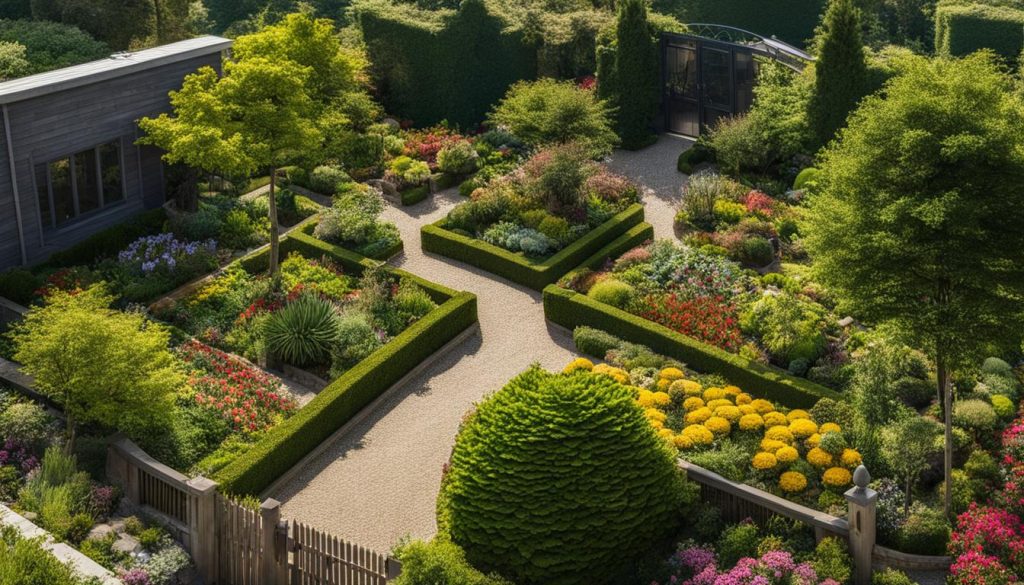
Planning Your Garden Layout
Planning a garden layout is an essential step in creating a stunning outdoor space. With a well-thought-out garden design, you can maximize the potential of your garden and create a harmonious and inviting environment. Here are some tips to help you plan your garden layout:
- Consider your garden’s unique features: Start by assessing your garden’s size, shape, topography, sunlight exposure, and any existing features. This will help you determine the areas that are best suited for different garden features and elements.
- Create zones within your garden: Divide your garden into different zones, such as seating areas, outdoor dining spaces, flower beds, and focal points. This will help you create a balanced and functional garden layout.
- Balance hardscaping and greenery: Find the right balance between hardscaping and greenery by incorporating pathways, patios, and retaining walls with plantings and flowers. This will help you create a garden that is beautiful and functional.
- Make sure the flow is just right: Think about the flow and accessibility of your garden. Consider how you and your guests will move around the space and make sure everything is easily accessible.
When planning your garden layout, don’t forget to incorporate your personal style and taste. Your garden should reflect your personality and be a space that you enjoy spending time in.
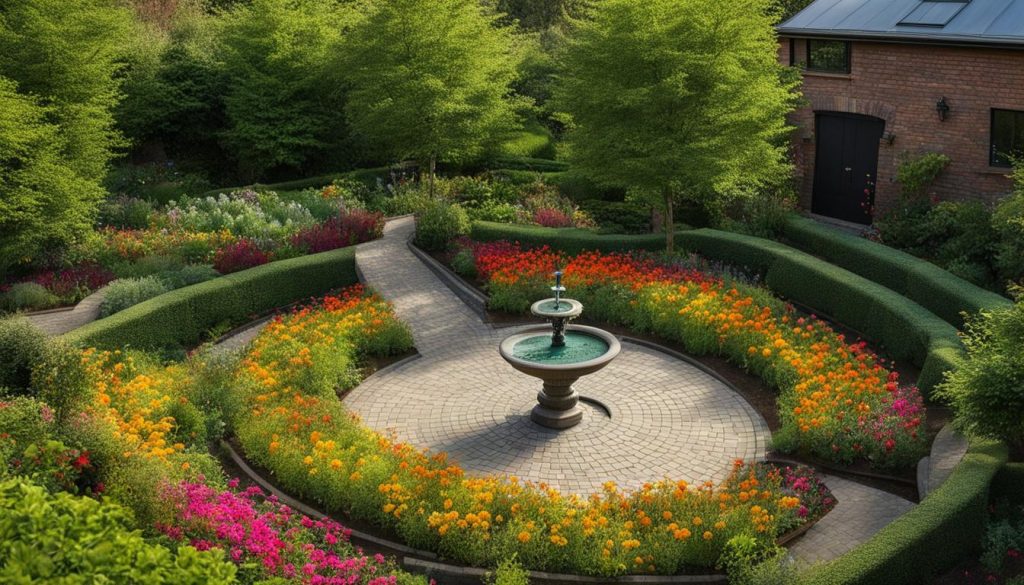
Choosing the Right Plants and Materials
When it comes to creating a stunning garden, choosing the right plants and materials is crucial. The plants you select should be ideally suited to the climate and soil conditions in your area, and their growth habits and maintenance requirements should align with your gardening skills. Similarly, the materials you choose for hardscaping elements such as pathways, patios, and retaining walls should be of high quality and durable enough to withstand the outdoor elements.
Considerations for Garden Plants
When selecting plants for your garden, there are several key considerations to keep in mind. These include:
- Climate: Choose plants that are well-suited to your region’s climate and weather patterns to ensure they thrive in your garden.
- Soil Conditions: Consider the soil type and quality in your garden, and select plants that are suited to these conditions.
- Growth Habits: Choose plants that grow well in your garden’s light exposure and that won’t overtake or overshadow other plants.
- Maintenance: Consider the time and effort required to maintain each plant, and choose varieties that align with your gardening expertise and willingness to care for them.
A mix of perennials and annuals can add interest and variety to your garden, and choosing plants with contrasting colors, textures, and shapes can create a visually stunning garden design.
Choosing Garden Materials
High-quality materials are essential for creating durable and aesthetically pleasing hardscaping elements in your garden. Consider the following factors when selecting materials:
- Durability: Hardscaping materials should be able to withstand the outdoor elements and last for years to come.
- Visual Appeal: Choose materials that complement the overall design aesthetic of your garden.
- Functionality: Consider the intended use of each hardscaping element and choose materials that can withstand its intended use.
Some popular hardscaping materials include natural stone, concrete pavers, bricks, and gravel. The right combination of plants and materials will help you create a stunning garden that reflects your personal style and enhances the natural beauty of your outdoor space.
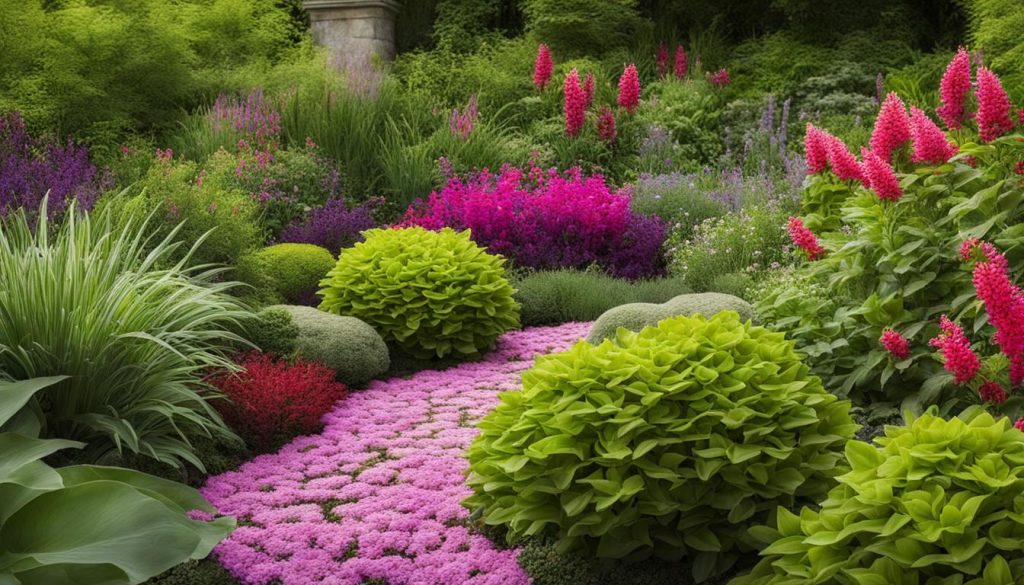
Incorporating Water Features
Water features can add an additional layer of tranquility and beauty to your garden. Consider adding a fountain, pond, or even a small waterfall to elevate the atmosphere. The gentle sound of running water can create a soothing ambiance, perfect for relaxing after a long day.
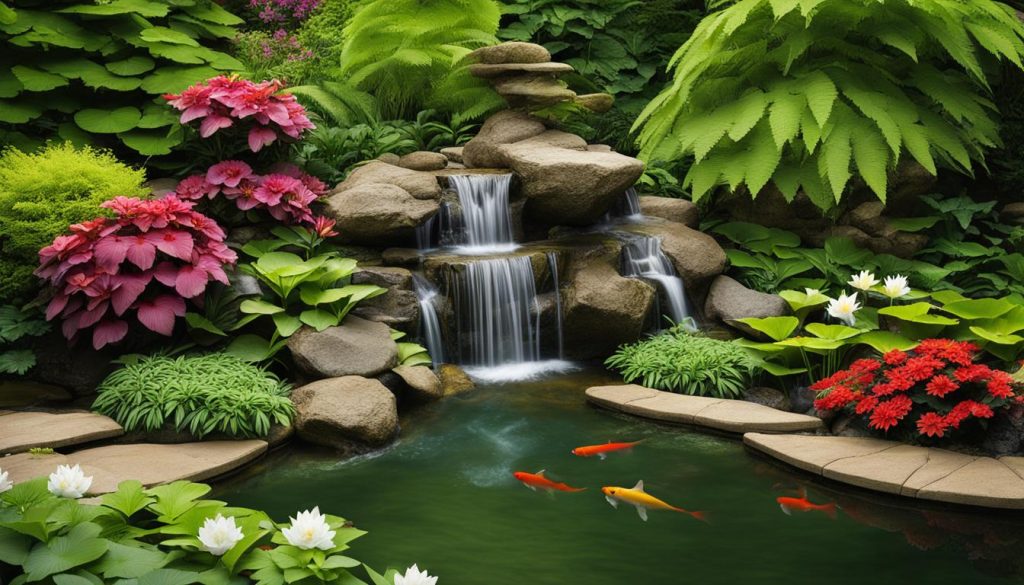
Garden Fountains
Fountains are a popular water feature for gardens. They come in various sizes and styles, allowing you to choose one that fits your garden’s aesthetic. A fountain can act as a focal point, drawing the eye and creating a dramatic effect. It can also attract birds and other wildlife, adding to the garden’s charm.
Ponds
Ponds are another popular water feature that can take your garden to the next level. They offer the opportunity to incorporate aquatic plants and fish, adding to the garden’s diversity. Ponds can be small or large, and can even incorporate a waterfall or stream for added interest.
When considering a pond, make sure to factor in the maintenance required. They will need to be regularly cleaned and maintained, especially if you plan on adding fish. However, with proper care, a pond can be a stunning addition to your garden.
Whether you choose a fountain, pond, or any other water feature, make sure to incorporate it seamlessly into your garden layout. Consider the surrounding plants and materials, and ensure that the water feature adds to the overall aesthetic without overpowering it.
Enhancing Privacy and Security
Privacy and security are important factors to consider when designing your garden space. You want to create a space that not only looks beautiful but also feels safe and secluded.
Exploring Fencing Options
One of the simplest ways to enhance privacy and security in your garden is by installing a fence. There are many different fencing options to choose from, including:
| Fencing Material | Pros | Cons |
|---|---|---|
| Wood | Natural look, affordable | Requires regular maintenance, may rot or warp over time |
| Vinyl | Durable, low maintenance, resistant to rot and insects | Can be more expensive than other materials, limited color options |
| Chain link | Durable, low maintenance, affordable | Offers little privacy, can look industrial or unattractive |
| Iron | Durable, elegant look, enhances property value | Can be expensive, requires professional installation |
Consider the pros and cons of each material before deciding which one is right for your garden.
Incorporating Natural Elements
In addition to fencing, you can also incorporate natural elements to enhance privacy and security in your garden. Here are a few ideas:
- Plant tall shrubs or trees along the perimeter of your garden
- Install a trellis and grow climbing plants like jasmine or honeysuckle for added privacy
- Place large planters or containers strategically to block views from certain angles
Adding Outdoor Lighting
Outdoor lighting is another effective way to increase security in your garden and highlight its beauty in the evenings. Consider installing motion sensor lights near any entrances or areas where someone could gain access to your property. You can also use accent lighting to highlight your favorite garden features, such as a fountain or statue.
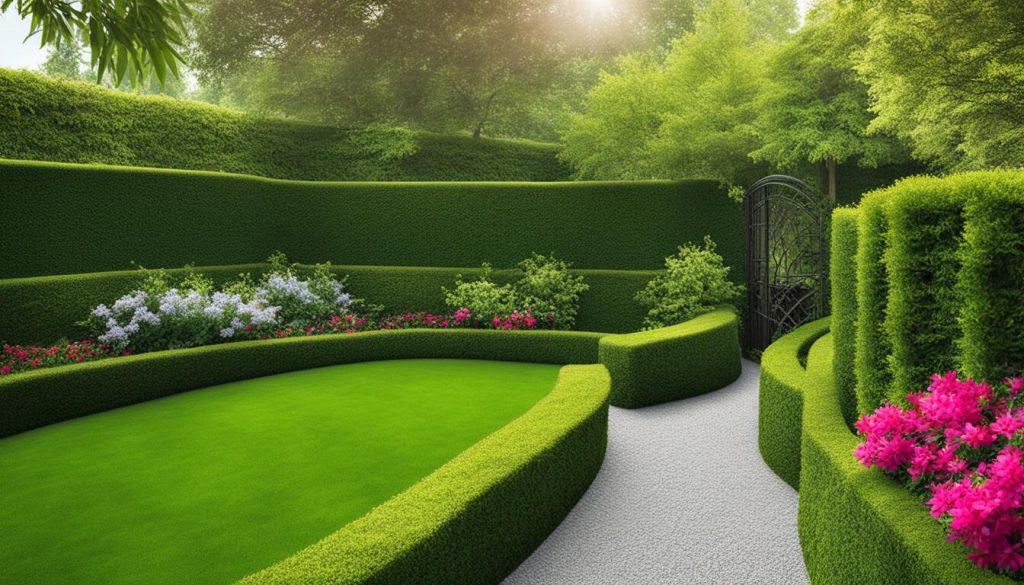
Maintaining Your Garden
Once your stunning garden is created, proper maintenance is crucial to keeping it healthy and thriving. Regular garden care will ensure that your plants and flowers remain vibrant year-round, and that your garden continues to be a beautiful space that you can enjoy.
Watering
Proper watering is essential to ensure that your garden stays healthy. Avoid overwatering your plants, as this can lead to root rot and other issues. Instead, water your garden deeply and infrequently. This will encourage deeper root growth and help your plants to become more drought-resistant over time.
Fertilizing
Fertilizing your garden is an important aspect of garden care. Choose the right fertilizer for your plants and apply it according to the instructions on the package. Too much fertilizer can damage your plants, so be sure to avoid over-application. Additionally, incorporating compost into your soil can provide natural nutrients and improve soil health.
Pruning
Regular pruning is essential to keep your plants and shrubs healthy and looking their best. Proper pruning can encourage new growth, improve air circulation, and help to prevent diseases. Be sure to use the right tools and techniques for each plant, as improper pruning can damage or even kill your plants.
Weeding
Weeding is an ongoing task in any garden. Regularly remove weeds to prevent them from spreading and competing with your plants for nutrients and moisture. Use a hoe or hand tool to remove weeds at their roots, or consider using a natural mulch or ground cover to help prevent weed growth.
Seasonal Tips
Each season brings its own challenges and opportunities for garden care. In the spring, be sure to remove any dead foliage or plants, and refresh your soil with compost. In the summer, provide shade for your plants during the hottest part of the day, and be sure to water them deeply during dry spells. In the fall, prepare your garden for winter by trimming back dead branches and protecting your plants from frost.
By following these garden maintenance tips, you can keep your stunning garden looking beautiful year-round. Happy gardening!
FAQ
How do I assess my garden space?
To assess your garden space, take a moment to evaluate the size, shape, and existing features of your garden. Consider factors such as the topography, sunlight exposure, and any potential challenges or limitations. By understanding the unique characteristics of your garden, you can create a tailored landscaping plan that maximizes its potential.
How do I plan my garden layout?
Planning your garden layout involves considering the different zones and areas you want to incorporate, such as seating areas, flower beds, and focal points. Take into account the balance between hardscaping and greenery, as well as the flow and accessibility within your garden. A well-planned garden layout will create a harmonious and inviting space.
How do I choose the right plants and materials for my garden?
When choosing plants, consider their suitability for your climate and soil conditions, as well as their growth habits and maintenance requirements. For hardscaping elements, select high-quality materials for pathways, patios, and retaining walls. The right combination of plants and materials will enhance the aesthetics and functionality of your garden.
How can I incorporate water features into my garden?
Consider adding a fountain, pond, or small waterfall to create a soothing atmosphere in your garden. Water features not only provide visual appeal but also attract birds and other wildlife, adding to the overall charm of your outdoor space.
What can I do to enhance privacy and security in my garden?
To enhance privacy, explore various fencing options or incorporate tall shrubs, trees, or trellises. For increased security, consider installing outdoor lighting. These additions will not only protect your space but also highlight the beauty of your garden during nighttime.
How do I maintain my garden?
Proper maintenance is key to keeping your garden looking stunning year-round. Learn about essential tasks such as watering, fertilizing, pruning, and weeding. Explore seasonal tips and tricks to ensure your garden stays healthy and vibrant in all seasons. With regular maintenance, you can enjoy the beauty of your garden for years to come.

